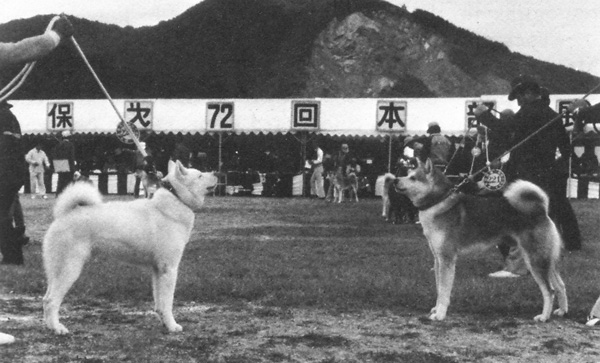|

Two Akita males in a typical
face-off position (Terrier style)
is the way they have always been shown in Japan. |
The
origin of the breed
The
Akita's story is a primeval one. The breed is the descendant of the
ancient dog with erect ears and curled tail whose likeness is found
carved in the early tombs of the Japanese.
In 660
B.C., dogs were brought to Japan from China and Korea. It is from these
ancestral beginnings that the Akita springs. However, actual
documentation of its existence didn't occur until the early 17th century
when a nobleman exiled to Akita Prefecture, a northern province on the
island of Honshu from which the breed takes its name, encouraged the
local aristocracy to develop a powerful hunting dog that possessed
superior intelligence and courage.
Ownership of one of these dogs was once restricted to the Imperial
family and the ruling aristocracy. Detailed care and feeding rituals
were developed as well as a special vocabulary used to address the dog
or when talking about them. Specially decorated leashes were used
denoting rank and standing of the dog and its owner. Each dog was
assigned a special caretaker who dressed in ceremonial garb signifying
his relationship to the dog and its status in the realm.
The
ancient Japanese word matagi, meaning esteemed hunter, was bestowed on
the best hunters in a village. Historically, the Akita was known as
matagiinu (esteemed hunting dog) by the hunters of the northern
Prefecture of Akita, who used pairs of dogs (a male and a female) to
hunt deer, bear, wild boar and Yezo, a type of large, fierce bear. When
hunting the Yezo, two dogs held the bear at bay until the hunter arrived
with spear or arrow.and wild boar. Akitas are highly prized
because they hunt silently.
Japanese
Akitas
Physically, the Akita is a large dog with upright ears and a curled
tail. It has great strength, a keen eye and nose, silence and speed. It
has a durable sturdy body suitable for hunting in deep snow. The
breed also was developed to retrieve downed waterfowl. Although it has
the strength and dentition necessary to crunch through frozen carrion,
its "soft" mouth when retrieving and delivering quarry to the hunter's
hand ensures downed waterfowl is never mangled. Akitas are even said to
have been used to drive fish into waiting nets.
Like
Japan's historical warrior class, the samurai, the Akita became a
fighting dog in the late 1800s and early 1900s. During this period,
other breeds were infused to enhance its fighting ability. However,
after the Akita was declared a natural monument in 1931, a movement
began with the goal of restoring the breed to its original, prefighting
form. At that time, three separate organizations formed to register it,
each having a breed standard of its own.
The
Akita thrives on companionship. The dog is dignified, good-natured,
alert, affectionate, docile, and courageous. It is fearless,
intelligent, and has a somewhat stubborn attitude. It is reserved in
demeanor with a strong protective instinct.
The
Akita has spiritual significance in Japan. Small statues of this dog are
typically given at the birth of a child to ensure health, happiness, and
a long life. They may be given during an illness as a get well wish.
Statues also stand guard over many tombs of the dead.
The
renowned Helen Keller brought the first Akitas to the United States when
a pair of dogs was presented to her as a gift from the Japanese Ministry
of Education. After World War II, occupational forces returning from
Japan brought the dogs they admired home and the popularity of the breed
increased.
Japanese
Akitas
|